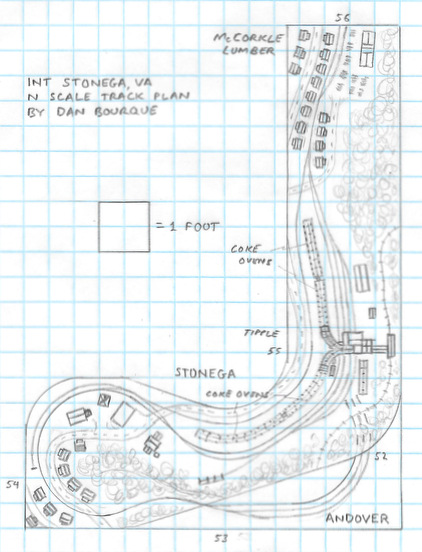- Size: 8′ x 10′
- Scale: N
- Minimum Radius: 15″
- Minimum Aisle Width: N/A
- Designed by Dan Bourque
 Stonega, VA, located just north of the Interstate Railroad’s headquarters in Andover, VA, was home to a large wooden tipple and four banks of coke ovens throughout the steam era of the Interstate. While its layout was simple, operations were anything but, and multiple mine run and yard crews worked this busy operation each day.
Stonega, VA, located just north of the Interstate Railroad’s headquarters in Andover, VA, was home to a large wooden tipple and four banks of coke ovens throughout the steam era of the Interstate. While its layout was simple, operations were anything but, and multiple mine run and yard crews worked this busy operation each day.
The Layout
This layout is designed to fit along two walls in a bedroom, basement or garage. It’s designed in N-scale and limited in scope to allow the modeler to capture a single operation relatively uncompressed and in great detail, though it could be easily converted into a 16′ x 20′ HO-scale plan. Much of the company town of Stonega is included, including the church, company store, superintendent’s house, and several rows of houses, both above and below the tipple. All tracks are modeled near scale, and even the shape of the layout is very similar to the geography of the valley in which Stonega lay. This allows for very interesting and prototypical operations. The only non-prototypical track work is McCorkle lumber. The saw mill loaded on the single tail track but further up the valley. I chose to include a siding for McCorkle to avoid it clogging the tail track operationally. A three-track staging yard underneath the tipple represents Andover, VA, where the Stonega mine runs originated. This layout could easily be operated using DC with blocks for the staging track and a single walk-around throttle.
Operations
This layout packs a surprising amount of operation into such a small layout, and it would take a couple of hours to run a full operating session. Based on all the moves required, this layout would benefit from a pair of operators (engineer and conductor). Stonega shut down in the year the Interstate fully dieselized in 1954, so mine runs would be powered by a smaller 2-8-0 and take one of the Interstate’s smaller cabs. During the height of operations in WWII, Stonega was served by 3 mine runs daily, the Day Stonega crew called at 11:00 AM, the Night Stonega crew called at 6:30 PM, and the Stonega Slack Wagon called at 11:00 PM. Hugh Wolfe describes the Stonega operations in great detail in the book Appalachian Coal Hauler, a “must have” for anyone interested in coal field operations. To aid in identifying tracks adjacent to the tipple, from left-to-right in the drawing above they are the #2 coke track, #1 coke track, Stonega main, #1 tipple track and #2 tipple track.
An operating session would start with a string of empties under the tipple on #2 tipple track, perhaps a handful of loaded hoppers on #1 tipple track, and a couple dozen “coke racks” (ventilated wooden boxcars) and coke hoppers scattered at various places along both sides of the coke ovens (coke tracks #1 and #2). A few empty coal hoppers on the trestle in Stonega and some empty gons and boxcars at McCorkle Lumber would fill out the stage. The Day Stonega Crew would leave Andover with a handful of empty hoppers, several coke racks, and perhaps some boxcars or gons of logs for McCorkle Lumber. After setting off any cars for McCorkle in the run-around and backing all the coke empties into the long stub track in Stonega, the crew would drop a few empty hoppers above the tipple on #1 track and retrieve the empties below the tipple on #2 track and place them on #1 above the tipple (these were the empties from the slack delivered the night prior). Then the crew would get to work on coke tracks #1 and 2. Working one of the tracks, the crew would back down and couple all the loads and partial loads (all cars) on the track and haul them onto the tail track where the full loads would be sorted from the partial loads that need to be returned to their original loading spots on the coke track. Next, the crew would have to grab coke empties and switch them back into the string of partial loads where the loads came out before spotting them all at the right spots along the coke track. Then, they’d have to do the same for the next coke track. After switching the coke tracks, the crew would work McCorkle and perhaps the coal trestle at Stonega before heading back to Andover.
The Night Stonega Crew would do the same thing with perhaps a few more loads added under the tipple. This time, the former “partial loads” of coke would be the loads ready to be gathered, and the former coke empties would now be the partial loads. The final crew of the session would be the Stonega Slack Wagon hauling several loads of slack (fine) coal for the tipple and perhaps a few loads of regular coal for the coal trestle. The Slack Wagon did most of its work in Andover Yard and at other tipples to gather the slack, so its job at Stonega was simply to place the slack hoppers above the tipple in #2 tipple track before returning to Andover. For variety, sessions could cover a less busy time with a single mine run, and some days it would only work the coke tracks because the tipple wasn’t loading.
Things I Like About this Plan:
- Relatively uncompressed
- Lots of switching required
- Great opportunity to model a whole company town
Things I Don’t Like About this Plan:
- Repetitive operations
- Singular focus
Related Products:




